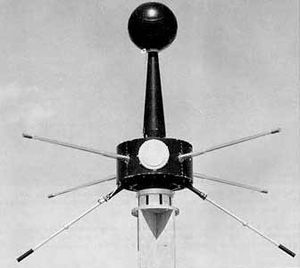
Back Explorer 10 Czech Explorer 10 German Explorer 10 French Explorer 10 Italian エクスプローラー10号 Japanese Explorer 10 LB Explorer 10 Polish Explorer 10 Portuguese Explorer 10 Slovak
 Explorer 10 satellite | |
| Names | P-14 Explorer X |
|---|---|
| Mission type | Space plasma physics |
| Operator | NASA |
| Harvard designation | 1961 Kappa 1 |
| COSPAR ID | 1961-010A |
| SATCAT no. | 00098 |
| Mission duration | 52 hours (achieved) |
| Spacecraft properties | |
| Spacecraft | Explorer X |
| Bus | P-14 |
| Manufacturer | Goddard Space Flight Center Massachusetts Institute of Technology |
| Launch mass | 35 kg (77 lb) |
| Start of mission | |
| Launch date | 25 March 1961, 15:17:04 GMT[1] |
| Rocket | Thor DM-19 Delta (Thor 295) |
| Launch site | Cape Canaveral, LC-17A |
| Contractor | Douglas Aircraft Company |
| Entered service | 25 March 1961 |
| End of mission | |
| Last contact | 27 March 1961 |
| Decay date | 30 June 1968 |
| Orbital parameters | |
| Reference system | Geocentric orbit[2] |
| Regime | Highly elliptical orbit |
| Perigee altitude | 221 km (137 mi) |
| Apogee altitude | 180,100 km (111,900 mi) |
| Inclination | 33.0° |
| Period | 83.50 hours |
| Instruments | |
| Faraday Cup Plasma Probe Rb-Vapor and Fluxgate Magnetometers Sun-Moon-Earth Aspect Sensor (Spacecraft) | |
Explorer program | |
Explorer 10 (also known as Explorer X or P14) was a NASA satellite that investigated Earth's magnetic field and nearby plasma. Launched on 25 March 1961, it was an early mission in the Explorer program and was the first satellite to measure the "shock wave" generated by a solar flare.[3]
- ^ McDowell, Jonathan (21 July 2021). "Launch Log". Jonathan's Space Page. Retrieved 4 November 2021.
- ^ McDowell, Jonathan. "Satellite Catalog". Jonathan's Space Page. Retrieved 4 November 2021.
- ^ "Display: Explorer 10 (P-14)". NASA. 28 October 2021. Retrieved 4 November 2021.
 This article incorporates text from this source, which is in the public domain.
This article incorporates text from this source, which is in the public domain.
© MMXXIII Rich X Search. We shall prevail. All rights reserved. Rich X Search